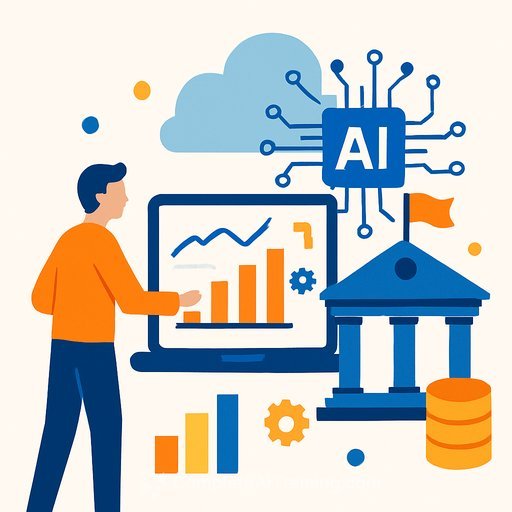How to Optimise AI Adoption in Public Sector Organisations
The UK government has announced a partnership with OpenAI to increase productivity across public services. The ambition is clear: deliver better outcomes for citizens and more capacity for teams. But AI doesn't fix weak infrastructure. It exposes it.
If you want AI to deliver consistent, measurable value, start with the basics: faster data movement, clear visibility, and strong control. That means modernising networks before scaling models.
Why infrastructure comes first
AI needs timely, accurate data to work well. Legacy networks struggle with volume, latency, and fragmentation-especially across hybrid estates and cloud environments. If telemetry, event streams, or application traffic can't move quickly, your AI gets stuck behind the very bottlenecks it's meant to solve.
This is why so many pilots stall. The model is fine. The plumbing isn't.
The data bottleneck is real
Many departments still rely on aging systems while demand climbs. The result is unreliable performance, blind spots, and longer triage times. As highlighted by the Public Accounts Committee, weak data quality, outdated tech stacks, and skills gaps are holding back delivery for users and teams.
What AIOps looks like in practice
AI for IT Operations (AIOps) becomes effective once data flows smoothly. Two capabilities matter most: accelerating application traffic and unifying observability. Together, they shorten the gap between issue, insight, and fix.
- Application acceleration: Move essential data quickly and consistently across complex estates-branch sites, hybrid work, remote devices, and cloud workloads. This reduces latency, removes chokepoints, and stabilises user experience.
- Unified observability: Correlate metrics, logs, traces, and experience data in one place. Track how AI services affect the network and end users. Detect anomalies, predict failures, and automate remediation before people feel the impact.
Once these are in place, AIOps can cut manual triage, reduce incident noise, and keep services available during peak demand.
Proof from UK public sector
The Princess Alexandra Hospital NHS Trust used observability tools to identify root causes and automate fixes. They reported saving approximately £3 million over five years while focusing staff time on patient care.
Richmond and Wandsworth Councils improved network application performance and employee experience across social care teams in a complex hybrid environment. The shared outcome: steadier services, fewer surprises, and more time for frontline work.
A practical roadmap for decision-makers
If you need to move fast without breaking services, use a phased plan. Start with the network, then stack AI on top of a cleaner, faster foundation.
- 1) Baseline the estate: Map critical user journeys (citizen portals, case management, clinical systems, benefits processing). Measure latency, packet loss, error rates, and mean time to resolve (MTTR) by location and app.
- 2) Fix flow first: Introduce application acceleration and prioritise traffic for critical services. Remove low-value chatter from congested links. Standardise QoS policies across WAN and cloud.
- 3) Unify visibility: Consolidate monitoring into one observability layer across on-prem, SaaS, and cloud. Include real user monitoring so you can see what citizens and staff actually experience.
- 4) Automate the obvious: Use AIOps to correlate alerts, close duplicate tickets, and trigger runbooks for recurring issues (e.g., DNS, certificate expiry, capacity thresholds).
- 5) Prove the value: Track time saved, incidents prevented, and experience gains. Share results with service owners and finance early.
- 6) Scale safely: Expand to more services, add predictive maintenance, and introduce change risk scoring for deployments.
Quick wins in the first 90 days
- Turn on synthetic tests for your top five citizen-facing journeys and key staff apps.
- Prioritise bandwidth for case management, EPR/EMR, and identity services; throttle non-critical updates during core hours.
- Automate ticket enrichment with context (topology, recent changes, user impact) to cut triage time.
- Apply anomaly detection to certificates, DNS, and API gateways-three common outage sources.
- Publish one page of weekly service health with actions taken. Keep it human and honest.
Metrics that matter
- Experience: Time to first byte, page load, transaction completion, login success rate.
- Stability: Incident volume, repeat incidents, MTTR, change failure rate.
- Flow: Latency by path, packet loss, throughput to critical apps, cache hit rates.
- Value: Hours saved per month, cost avoidance from prevented outages, citizen satisfaction scores.
Common pitfalls to avoid
- Launching AI pilots on top of fragile networks and expecting miracles.
- Collecting data without correlating it-lots of charts, no decisions.
- Skipping runbook automation-teams stay stuck firefighting the same issues.
- Hiding pain points-trust fades when services fail without clear comms.
Security and trust
As you modernise, fold security in from day one. Apply zero trust principles, protect telemetry pipelines, and set guardrails for model access and prompts. Keep an audit trail for decisions made by AI-supported operations.
For guidance, see the NCSC's principles for AI systems: NCSC AI security guidance.
Skills and capability
AIOps and observability reduce manual load, but people still set the standards and tune the system. Upskill teams on performance analysis, runbook automation, and responsible AI use. Train service owners to read experience data and act on it.
If you need structured options for team upskilling, explore role-based programs here: Complete AI Training: Courses by Job.
The takeaway
Infrastructure readiness is the starting point, not an afterthought. Accelerate data flow, make performance visible, and automate the repeatable work. Then scale AIOps across services with confidence.
The sooner these foundations are in place, the sooner you'll convert AI ambition into measurable impact-for operations, for teams, and for the citizens you serve.
Your membership also unlocks:






